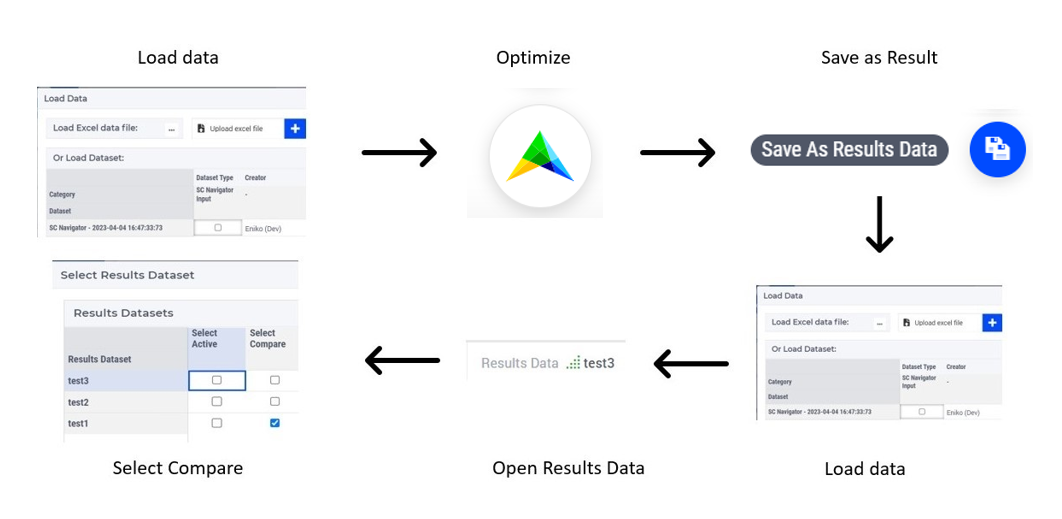Differences between SC Navigator and Network Design
The usage and the way of working of SC Navigator differ from Network Design in certain respects, such as:
Next we explain each of these differences in more detail.
No Configuration required
When using Network Design, firstly you have to load the template in Data Navigator and create a configuration for it. This is not required for SC Navigator, where you can load the dataset or the Excel template directly, without creating a configuration or using Data Navigator. More specifically, you can load the data by clicking the Input Data button and then choose whether to load an Excel template or select a dataset (scenario), instead. You can find more information about data loading in the section Getting Started.
New Workflow
The workflow has been changed in several ways.
After loading the input data, the page Main Map will be visible in SC Navigator and not the Control Panel page, which is the case in Network Design. If you want to change the input data, you can do this on different Data pages (see the section Data) and not on the Control Panel page. For example, if you want to change the minimum capacity of a warehouse, in SC Navigator you should go to the Warehouse Data page, while in Network Design you should do this on the Control Panel page.
In SC Navigator the Control Panel page is used for setting options for optimization (see the section Control Panel find more details about this).
You can manage datasets and download Excel template on the Manage Data page in SC Navigator. There you can also open the dialog page Overview of Optimization Results, which is called Job List in Network Design. After the optimization has been completed, you can get an overview of the results on the main map on the Results page. However, there is no separate button for the results map and the details, like in Network Design. Also, there is no Cost Report page, like in Network Design; instead, the page KPI Overview with a similar structure is available in SC Navigator.
New Template
The template used by SC Navigator is different from the template in Network Design in several ways:
Instead of DCs, SC Navigator uses the name Warehouse.
There is no Production Product sheet, you can define only BOMs for Productions. For Suppliers only product out of thin air can be defined and for Warehouses only throughput.
The usage of BOM is changed, there is no production of nothing, only multiple input to multiple output is allowed. In SC Navigator there is an error message for this and on the Data Issues page you can find which product is created out of nothing in each period.
You can define the same attributes (e.g.: maximum capacity, minimum capacity, variable cost) for Suppliers, Productions, and Warehouses.
There is no uplift functionality for Warehouses and Productions. Instead, there are steps which are applied across Suppliers, Productions, and Warehouses and the steps are unlimited.
There in no Exclude (Transport) column in the template, as is the case in Network Design. Instead, in SC Navigator there are Force Open and Force Close columns in then Transport Cost sheet.
There are two ways to specify group data: define group data as in Network Design or use Curly Brackets {}. These two ways are handled differently in the model. You can read more about groups in the section Group elements in the Data.
In Network Design, if a Rate Card is out of the specified distance or weight break bands, then the lane is not used. However, in SC Navigator there is an error message for this and on the Data Issues page more information about the error is provided.
Define Constraints
The handling of some constraints is different in SC Navigator compared to Network Design.
In SC Navigator conditional constraints have a different default. For example, if a maximum capacity constraint is defined for a warehouse, but the Force Open attribute is not applied to that warehouse, then the maximum capacity constraint is just conditional. However, if the Force Open attribute is applied, then the constraint must be met.
Unlike Network Design, there is no Transport Constraint Data table in SC Navigator, but the constraints can be found in the Transportation Data, instead.
In Network Design the attribute Cost is Incremental was used. However, in SC Navigator a new attribute called Variable Cost is for all steps is introduced. If a template which has Cost is Incremental attribute is loaded to SC Navigator (for backwards compatibility), then this attribute works in the opposite way, namely: if equal to '0', then the variable cost is applied for all steps.
In Network Design there was Single Source for customers and resources. In SC Navigator it is generalized: you can define Max # source locations for Customers, Max # source locations for Resources, and Max # destination locations. Each of these can be defined on the product level.
Case Comparison
In Network Design there are two options to compare scenarios: choose the Compare Scenarios option in the Workflow or use the WebUI case comparison functionality.
In SC Navigator you can compare scenarios from the status bar as follows:
Load the first dataset using the Load Data Dialog
Optimize
Load the second dataset
Click on the Result Data button on the status bar
For the first scenario choose the Select Compare option
Now the second scenario will be the active scenario and the first scenario is compared to it

Location Filters
The layout of the location filters is different in the two application. In Network Design, for example, the Customer Location filter can be found under the Customer Filters filter on the same side panel.
In SC Navigator the two filters are on the same side panel, but the Location filter is accessible via the "three dot" menu. You can switch to location view as follows:









